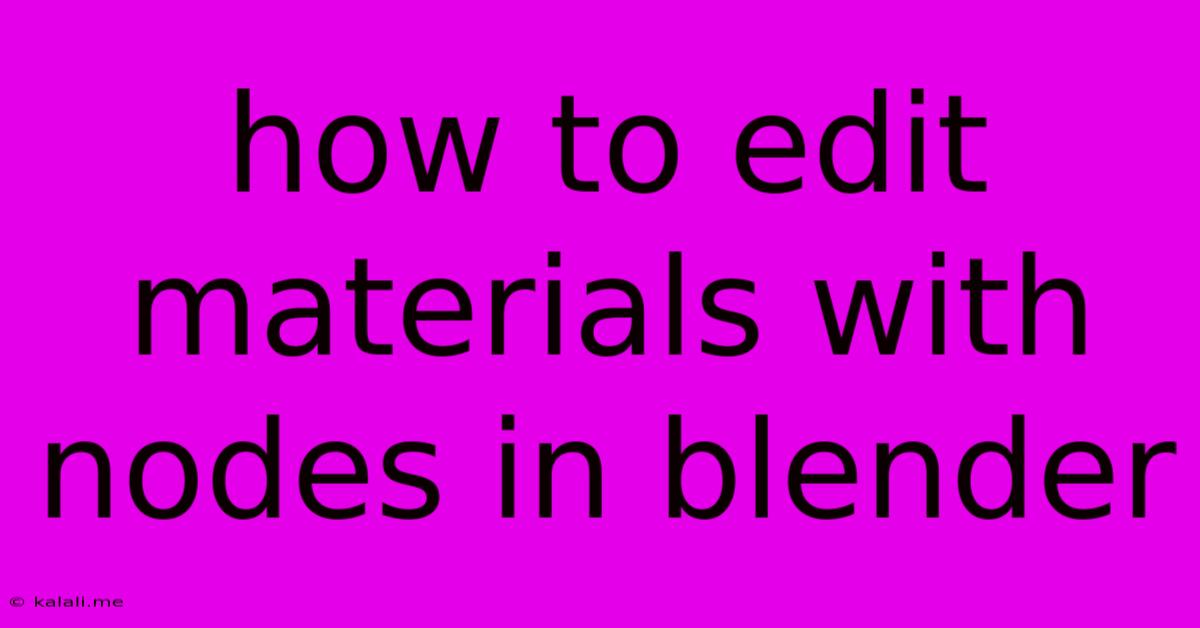How To Edit Materials With Nodes In Blender
Kalali
May 23, 2025 · 3 min read

Table of Contents
Mastering Material Editing with Nodes in Blender: A Comprehensive Guide
This article provides a comprehensive guide to mastering material editing using nodes in Blender. We'll cover everything from the basics of the node editor to advanced techniques for creating realistic and stylized materials. Learn how to manipulate textures, control shaders, and achieve stunning visual effects. This will help you create impressive renders for your 3D projects.
Understanding the Node Editor
The Blender node editor is a powerful tool that allows for non-destructive material creation. This means you can modify your materials without affecting the original settings. This is crucial for iterative design and experimentation. The core components are:
-
Nodes: These are the building blocks of your material. Each node performs a specific function, such as loading an image texture, mixing colors, or adjusting surface roughness. Common nodes include:
- Principled BSDF: The standard shader for most materials, controlling aspects like base color, roughness, metallic, and more.
- Image Texture: Loads image files as textures for your material.
- Mix Shader: Blends multiple shaders together, allowing for complex material combinations.
- Color Ramp: Creates gradients between colors, useful for controlling texture intensity or creating special effects.
- Normal Map: Adds surface detail to your model, enhancing realism.
- Bump Map: Similar to a normal map, but affects the surface's perceived height.
-
Sockets: These are the input and output points of each node. They determine how nodes connect and exchange data.
-
Links: These connections between sockets transmit information between nodes.
Basic Workflow: Creating a Simple Material
Let's create a simple wood material.
-
Add a Material: Select your object and go to the "Material Properties" panel. Click "New."
-
Open the Node Editor: In the Material Properties panel, switch to the "Shader Editor" workspace.
-
Add Nodes: Add a
Principled BSDFnode (it's usually there by default). Then, add anImage Texturenode. Browse to your wood texture image. -
Connect Nodes: Connect the
Image Texture'sColoroutput to thePrincipled BSDF'sBase Colorinput. -
Adjust Settings: Tweak the
Principled BSDF's settings (roughness, metallic, etc.) to fine-tune the appearance of your wood material. Experiment with theImage Texture's settings like scaling and color correction.
Advanced Techniques: Taking Your Materials to the Next Level
Once you're comfortable with the basics, you can explore more advanced techniques:
-
Normal and Height Maps: Use normal and height maps to add realistic surface detail. Connect these to the appropriate inputs of the
Principled BSDF. Experiment with different map types for diverse effects. -
Mix Shaders for Complex Materials: Combine different shaders (e.g.,
Principled BSDFandEmission) to create materials with unique properties, like glowing or translucent effects. -
Using Color Ramps for Control: Employ color ramps to manipulate texture intensity or create dynamic effects within your materials.
-
Procedural Textures: Generate textures directly within Blender using nodes like
Noise Texture,Voronoi Texture, andMusgrave Texture. This offers unparalleled creative control and allows for unique material designs. -
Shader Modifiers: Utilize shader modifiers like
Subsurface Scatteringfor materials like skin or wax to improve realism. -
Material Libraries: Explore Blender's built-in material libraries or online resources for pre-made materials and node setups to accelerate your workflow and discover new techniques.
Conclusion: Embrace the Power of Nodes
Mastering the Blender node editor unlocks a world of creative possibilities for material creation. Through experimentation and understanding the functionalities of each node, you can create incredibly realistic and stylized materials for your 3D projects, elevating your work to a new level of sophistication. Don't be afraid to experiment and explore the countless possibilities within this powerful tool. Remember to save your node setups for future use, and always back up your work regularly.
Latest Posts
Latest Posts
-
Magento 2 Create A Js To Extend Shipping Js
May 23, 2025
-
What Is The Eigenvector For Identity Matrix
May 23, 2025
-
Graphql Using And In Where Clause Lwc Example
May 23, 2025
-
Data In Ml Upper Superscript Sample Or Dimension
May 23, 2025
-
And Then She Went To Work
May 23, 2025
Related Post
Thank you for visiting our website which covers about How To Edit Materials With Nodes In Blender . We hope the information provided has been useful to you. Feel free to contact us if you have any questions or need further assistance. See you next time and don't miss to bookmark.